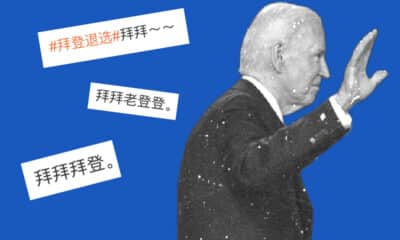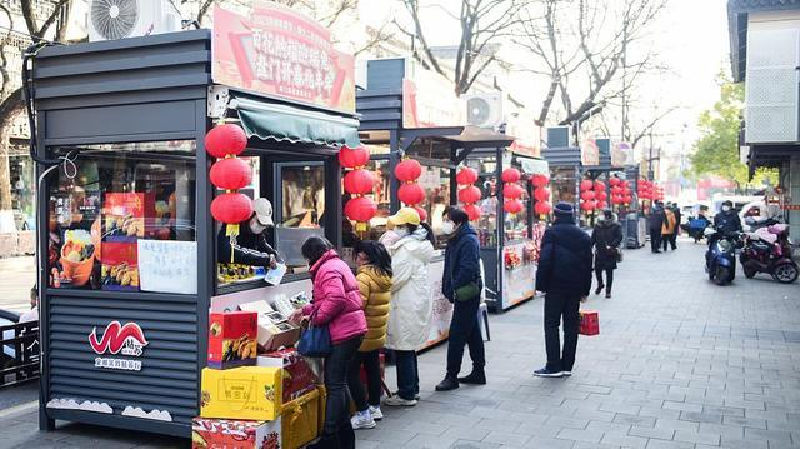China and Covid19
Victory of Perseverance? Visions of China’s ‘Dynamic Zero’ Covid Future
Many commenters have a less rose-colored view of the future of ‘zero Covid’ than some of China’s opinion makers.
Published
2 years agoon

While China is seeing the worst Covid outbreak in months and resentment is rising over strict lockdowns and ‘excessive’ Covid measures, Chinese political pundits and opinion leaders are painting a rosy picture of the future of China’s ‘zero Covid’ policy.
It is the Start of Winter (立冬) and China is seeing a spike in Covid-19 cases across the country.
There currently are approximately 40,000 confirmed Covid cases in the mainland, with the biggest outbreaks taking place in Guangdong, Inner Mongolia, and Xinjiang.
At the same time, frustrations over strict lockdowns and excessive anti-epidemic measures have been building recently, and there has been a lot of anger over a lack of emergency medical care for people in isolation in, among others, Ruzhou, Lanzhou, and Hohhot.
On Monday, November 7, political commentator Hu Xijin (@胡锡进), who used to be the editor-in-chief of Global Times, commented on China’s ‘dynamic zero’ Covid policy. Hu does so more often – in September 2022 he also published a lengthy post about China’s epidemic prevention.
China’s zero Covid policy is all about the speedy detection of new cases, followed by a quick response to curb the spread of the virus immediately and bring the epidemic situation under control. Because it is an ongoing process, it is called ‘dynamic zero’ (动态清零), with cases being extinguished soon after they are detected and with the eventual goal of having zero new infections in society (社会面清零).
The former journalist Hu, whose posts and statements often go trending and influence public opinion, made a few noteworthy comments in his recent post.
Hu suggested that the strict lockdowns in some parts of China are just not sustainable and that cities should stop striving to reach complete elimination of Covid cases. Instead, he advocated for a more relaxed and local approach, but did point out that Chinese cities could perhaps get back to focusing on reaching “zero” cases in the summer of 2023 (“到了明年夏天,也许一些城市可以重新追求零感染”).
By adhering to a model where Chinese regions stay in complete control when it’s about the spread of the virus, China will have drastically fewer deaths than in the West and its ‘dynamic zero’ approach will be remembered as a historical, “world-renowned achievement,” according to Hu.
“If we can remain in overall control and can keep the number of deaths far lower than in the West (..) then our epidemic prevention will benefit all 1.4 billion Chinese people, and will shine throughout history!”
Early on in his post, Hu Xijin suggests that the goal of ‘zero Covid’ is not actually to reach zero cases, but to keep the Covid outbreak in China under control:
“The ‘dynamic zero’ [policy] is not really about pursuing zero infections at all times, it is about continuing to keep the epidemic situation under control. Reaching absolutely zero infections should not be the goal of every city for this winter; by summer of next year, some cities can perhaps again pursue to have zero infections, but it is not realistic for this winter season. Thoroughly eliminating an especially active virus would exceed the basic level management capabilities in the majority of cities and the situation in Urumqi, Zhengzhou, and other cities shows that even if you carry out strict and lengthy lockdowns, the virus still continues to spread throughout the community.”
Hu Xijin suggests that Beijing is the number one city in China when it comes to efficiently implementing Covid measures and responding to new cases. Yet, even Beijing is now seeing a spike in new cases, so Hu’s reasoning is that if Beijing can’t even reach ‘zero’ Covid, then no other city can.
If ‘zero’ Covid is impossible, Hu implies, cities might as well be a bit more relaxed in their epidemic approach because the socio-economic cost of doing city-wide or district-wide lockdowns is so high, while the effects might be relatively minimal: Covid will still find a way. Hu writes:
“Beijing hasn’t carried out a large-scale lockdown, and the economic and social life in the city has been the most relaxed of the nation. Lockdowns have all been done locally [small-scale], and as everyone saw, Beijing held its first marathon in three years yesterday. That’s another step forwards. When there are outbreaks in other cities, especially when cases are scattered, and cities want to reach ‘zero Covid,’ they can only do that through the method of wide-scale or even total static management. But even if it is done like that, it does not mean they can realize a total elimination of Covid cases this winter while the social and economic costs of pursuing a ‘zero Covid’ goal are actually too high. The reality across the country is that people are less and less willing to cooperate with area-wide static management [lockdowns]. Regardless of whether you look at it from the standpoint of public opinion or from that of the financial burden, it is not sustainable to go on like that.”
Hu suggests that focusing on keeping infection rates low is more effective than maintaining a ‘zero’ Covid policy. By focusing on lower numbers instead of zero cases, cities can keep the burden on social and economic life low, while also avoiding an epidemic crisis. This basically is what ‘dynamic zero’ is all about.

Anti-epidemic workers waving a Chinese flag, posted via @漫长岁月
In the conclusion of his post, Hu calls China’s epidemic prevention a “world-renowned success” that has saved the lives of millions of people over the past three years:
“Facing new circumstances, if we can maintain complete control, and can keep the number of deaths far lower than in the West while also safeguarding our economy and the order of social development, then our epidemic prevention – at every stage and in its entirety – and its achievements will benefit all 1.4 billion Chinese people, and will shine throughout history!“
Hu Xijin’s lengthy post and rose-colored outlook on the future of Covid zero received over 11,000 ‘likes’, but clearly did not impress all of his readers. Some replied: “So you’re basically just explaining the concept of the zero Covid policy again?” “Beijing the most relaxed?” others wondered.
“Stop wide-scale nucleic acid testing!” some said, with others replying: “We can’t continue to blindly follow the zero Covid policy.” “Listen to the voices of the people.”
Another commenter replied: “If we still want to be practical and realistic, we must admit that zero Covid is impossible, and we can’t pay such a high price to go on a mission that will never end. We should revise the general policy and insist on controlling the scale, protecting lives, and preventing hospitalization.”
Some who replied did agree with Hu’s words, writing: “A world-renowned success: it highlights the necessity of unswervingly insisting on ‘dynamic zero’!”
“What must we hold on to? The dynamic Zero Covid policy! Let the West lie flat, because the pandemic will have serious repercussions for them.”
Hu Xijin is not the only Chinese opinion maker who is describing the country’s zero Covid strategy as one that will go down in history as a glorious victory.
In late October, a short video went viral on Twitter showing a Chinese businessman giving a speech in which he claimed China would come out of the pandemic as the winner since the West would be brought to its knees because of the long-term impact of the pandemic. He explicitly mentioned long Covid and its supposed devastating effects on the labor force in the West.
A Chinese business consultant in a Ted-style talk justified zero-Covid policy by saying that in 10 years the West will be brought to its knees b/c long-Covid, which will decimate most of its labor force. pic.twitter.com/kQRTDYE813
— Yanzhong Huang (@YanzhongHuang) October 30, 2022
“I can only say, you’d have to be stupid if you want to give up [lie flat] now. We definitely cannot give up now. What must we hold on to? The dynamic Zero Covid policy! Understand? Let the West not do anything [lie flat], because the pandemic will have serious repercussions for them. So we definitely cannot let it go. So as an ordinary consumer, an ordinary citizen, we cannot forget national humiliation. The people inside the system are much smarter and more advanced than we are. You do not get the basic picture at all. (..) Just do what you’re told. We will win. If the epidemic continues another ten years, we don’t need to fight anymore, the whole world will have fallen.”
The man speaking is Gu Junhui (顾均辉), a finance, business, and strategic positioning expert with a very small following of 336 fans on his Weibo account.
As Gu’s video was widely shared on Twitter, it also started circulating on Chinese social media, where the majority of commenters dismissed Gu Junhui as another self-proclaimed ‘expert’ riding his high horse: “Nobody is listening to this idiot.”
Others ridiculed him for such a stance, writing: “So China can finally win if the West dies out?!” Some even suggested that Gu was a comedian instead of a finance expert.
Despite the online banter, Gu’s vision of China’s dynamic zero Covid future is a recurring one in China’s online media sphere, where other bloggers and authors also measure China’s success through U.S. failures.
Blogger/author Lu Xiaozhou (@卢晓周) wrote on Weibo on November 8 that the U.S. will be drained out because it chose to “lie flat” and live together with Covid-19, a virus that is unpredictable and which scientists around the world still have not figured out.
He says that China, on the other hand, is maintaining a balance between social stability and economic development through its dynamic zero Covid policy.
According to Lu, it’s simple: dynamic zero Covid is “right” whereas coexisting with the virus is “wrong.”
“The dynamic zero Covid policy comes at a high price, and when we give up dynamic zero, we will welcome a big epidemic wave. No matter if it happens this year, next year, in five years’ time, in ten years’ time, or in fifty years’ time, that moment will eventually come.”
During a press conference Saturday, Chinese health officials stated that China would “unswervingly” stick to its zero Covid policy. A hashtag about the topic (#坚持动态清零总方针不动摇#) received 220 million views on Weibo.
In October of this year, Chinese Party newspaper People’s Daily (人民日报) already published an article titled “Dynamic Zero Is Sustainable and Must Be Adhered To” (“动态清零”可持续而且必须坚持”) (read more).

Nucleic acid testing, photo by @dotdotnews.
It is clear that many commenters have a less rose-colored view of the future of ‘zero Covid’ than some of the opinion makers.
One Zhejiang-based doctor named Gong Xiaoming with over 4,6 million followers on Weibo (@龚晓明医生) had a more sober expectation of the future:
“I was prohibited from posting for three months last year after I commented on the epidemic, but I still want to speak my mind. The dynamic zero Covid policy comes at a high price and when we give up dynamic zero Covid, it means we will welcome a big epidemic wave. That moment in time, no matter if it happens this year, next year, in five years’ time, or in ten years’ time, or in fifty years’ time, it will eventually come. So the authorities in every region must ask themselves one question: when then moment comes, are we ready?”
Dr. Gong continues:
“The 1 per 1,000 mortality figure is backed by enough medical resources, and it will probably be higher when there is an instant influx of patients and we don’t have enough medical resources. What is even more important in relation to the mortality rate is: do we have enough intensive care beds? If we still have another year, then let us please use this precious time to strengthen the establishment of the ICUs at local hospitals, to set up respiratory intensive care units, and let use this time to purchase good mechanical ventilators and equipment, strengthen the staff team, especially the medical team, which is not something that can be done within a day or not even within a month. A month ago I paid a visit to a county town with 200,000 inhabitants and the county hospital did not have one single IC bed. This made me deeply concerned. Perhaps I’m overly anxious, and the government might already be taking these steps, but if regional leaders have the vision, please strengthen your local hospital’s intensive care medical departments. Our timeframe is getting shorter. In addition to the construction of ICU, there is also medication, vaccines and other issues that need to be considered.”
Dr. Gong uses graphs with data from Taiwan to support his story, showing an uptick of cases after Taiwan let go of its own ‘zero Covid’ policy in April of 2022.
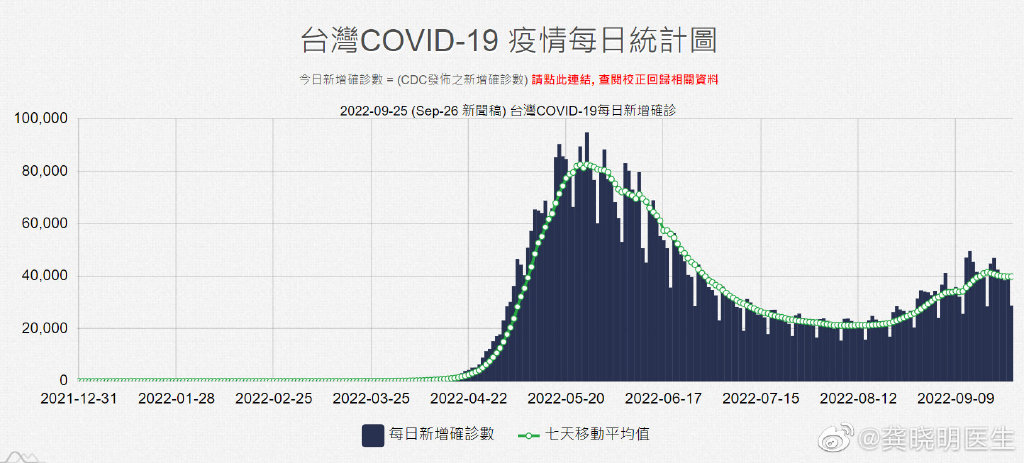
Other voices also express similar visions on the future of dynamic zero in China, seeking for science-based prospects and realistic strategies: “I really hope that the authorities can provide timely and accurate information. The main point is not whether or not we should have the dynamic zero policy, but rather how we can go forward with dynamic zero on a scientific basis,” another popular blogger (@卢麒元) wrote.
Although Dr. Gong’s post was reposted hundreds of times, the comment section was not available at the time of writing (“抱歉,该内容暂时无法查看”).
Political commentator Hu Xijin should be able to appreciate Dr. Gong’s input. In September of this year, Hu argued that more Chinese experts should come forward with suggestions and views based on science in order for the online discourse to focus more on science and rationality rather than letting “discussions be dominated by loud voices on social media.”
By Manya Koetse
Follow @WhatsOnWeibo
-Photo by Xiangkun ZHU on Unsplash
-Photo by Yun XU on Unsplash
– Photo by Guido Hofmann on Unsplash
Get the story behind the hashtag. Subscribe to What’s on Weibo here to receive our newsletter and get access to our latest articles:
Spotted a mistake or want to add something? Please let us know in comments below or email us. First-time commenters, please be patient – we will have to manually approve your comment before it appears.
©2022 Whatsonweibo. All rights reserved. Do not reproduce our content without permission – you can contact us at info@whatsonweibo.com.
Manya Koetse is the founder and editor-in-chief of whatsonweibo.com. She is a writer, public speaker, and researcher (Sinologist, MPhil) on social trends, digital developments, and new media in an ever-changing China, with a focus on Chinese society, pop culture, and gender issues. She shares her love for hotpot on hotpotambassador.com. Contact at manya@whatsonweibo.com, or follow on Twitter.

Also Read
China and Covid19
Sick Kids, Worried Parents, Overcrowded Hospitals: China’s Peak Flu Season on the Way
“Besides Mycoplasma infections, cases include influenza, Covid-19, Norovirus, and Adenovirus. Heading straight to the hospital could mean entering a cesspool of viruses.”
Published
8 months agoon
November 22, 2023
In the early morning of November 21, parents are already queuing up at Xi’an Children’s Hospital with their sons and daughters. It’s not even the line for a doctor’s appointment, but rather for the removal of IV needles.
The scene was captured in a recent video, only one among many videos and images that have been making their rounds on Chinese social media these days (#凌晨的儿童医院拔针也要排队#).
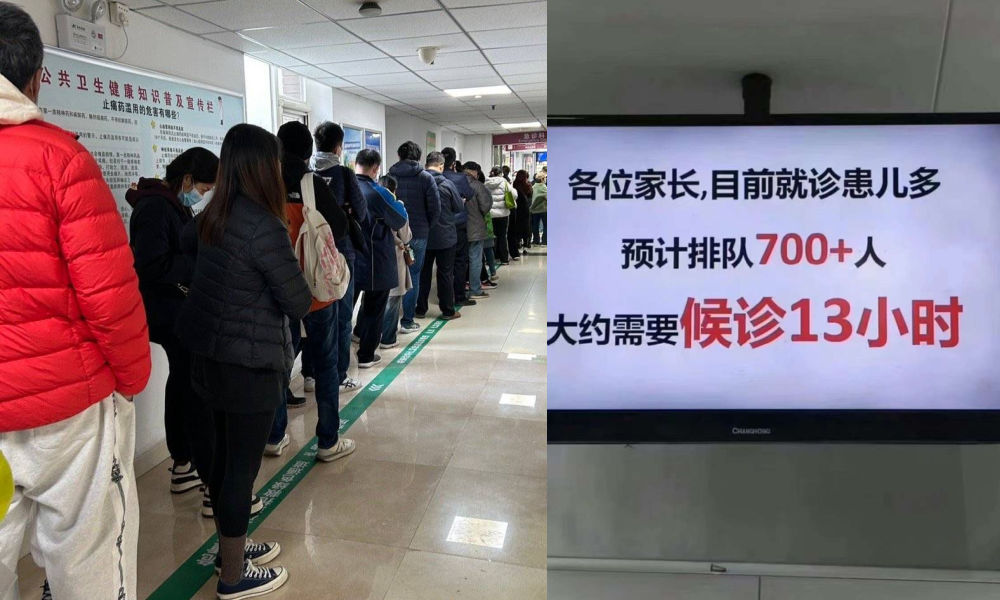
One photo shows a bulletin board at a local hospital warning parents that over 700 patients are waiting in line, estimating a waiting time of more than 13 hours to see a doctor.
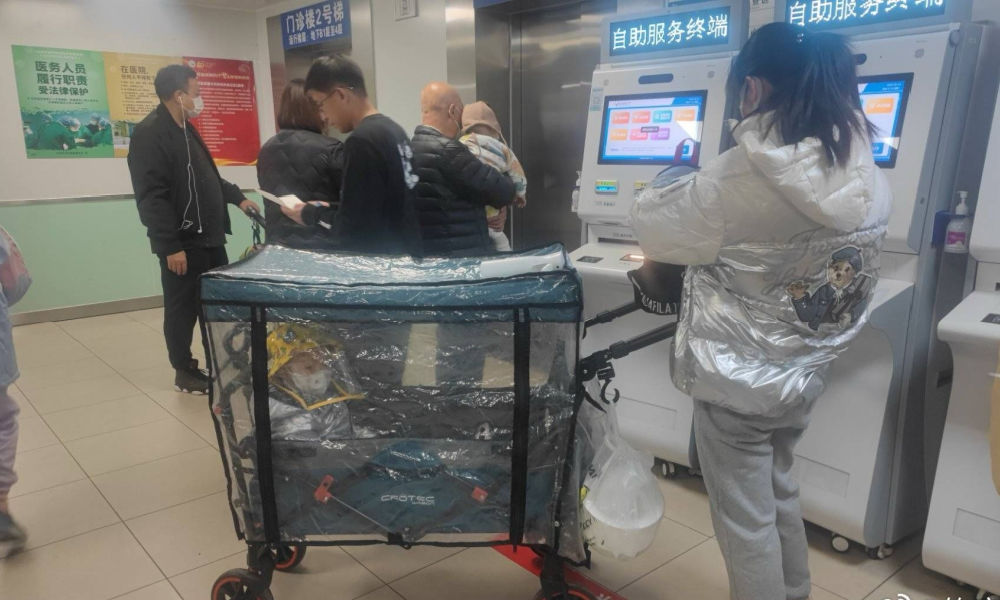
Another image shows children doing their homework while hooked up on an IV.

Recent discussions on Chinese social media platforms have highlighted a notable surge in flu cases. The ongoing flu season is particularly impacting children, with multiple viruses concurrently circulating and contributing to a high incidence of respiratory infections.
Among the prevalent respiratory infections affecting children are Mycoplasma pneumoniae infections, influenza, and Adenovirus infection.
The spike in flu cases has resulted in overcrowded children’s hospitals in Beijing and other Chinese cities. Parents sometimes have to wait in line for hours to get an appointment or pick up medication.
According to one reporter at Haibao News (海报新闻), there were so many patients at the Children’s Hospital of Capital Institute of Pediatrics (首都儿科研究所) on November 21st that the outpatient desk stopped accepting new patients by the afternoon. Meanwhile, 628 people were waiting in line to see a doctor at the emergency department.
Reflecting on the past few years, the current flu season marks China’s first ‘normal’ flu peak season since the outbreak of Covid-19 in late 2019 / early 2020 and the end of its stringent zero-Covid policies in December 2022. Compared to many other countries, wearing masks was also commonplace for much longer following the relaxation of Covid policies.
Hu Xijin, the well-known political commentator, noted on Weibo that this year’s flu season seems to be far worse than that of the years before. He also shared that his own granddaughter was suffering from a 40 degrees fever.
“We’re all running a fever in our home. But I didn’t dare to go to the hospital today, although I want my child to go to the hospital tomorrow. I heard waiting times are up to five hours now,” one Weibo user wrote.
“Half of the kids in my child’s class are sick now. The hospital is overflowing with people,” another person commented.
One mother described how her 7-year-old child had been running a fever for eight days already. Seeking medical attention on the first day, the initial diagnosis was a cold. As the fever persisted, daily visits to the hospital ensued, involving multiple hours for IV fluid administration.
While this account stems from a single Weibo post within a fever-advice community, it highlights a broader trend: many parents swiftly resort to hospital visits at the first signs of flu or fever. Several factors contribute to this, including a lack of General Practitioners in China, making hospitals the primary choice for medical consultations also in non-urgent cases.
There is also a strong belief in the efficacy of IV infusion therapy, whether fluid-based or containing medication, as the quickest path to recovery. Multiple factors contribute to the widespread and sometimes irrational use of IV infusions in China. Some clinics are profit-driven and see IV infusions as a way to make more money. Widespread expectations among Chinese patients that IV infusions will make them feel better also play a role, along with some physicians’ lacking knowledge of IV therapy or their uncertainty to distinguish bacterial from viral infections (read more here)
To prevent an overwhelming influx of patients to hospitals, Chinese state media, citing specialists, advise parents to seek medical attention at the hospital only for sick infants under three months old displaying clear signs of fever (with or without cough). For older children, it is recommended to consult a doctor if a high fever persists for 3 to 5 days or if there is a deterioration in respiratory symptoms. Children dealing with fever and (mild) respiratory symptoms can otherwise recover at home.
One Weibo blogger (@奶霸知道) warned parents that taking their child straight to the hospital on the first day of them getting sick could actually be a bad idea. They write:
“(..) pediatric departments are already packed with patients, and it’s not just Mycoplasma infections anymore. Cases include influenza, Covid-19, Norovirus, and Adenovirus. And then, of course, those with bad luck are cross-infected with multiple viruses at the same time, leading to endless cycles. Therefore, if your child experiences mild coughing or a slight fever, consider observing at home first. Heading straight to the hospital could mean entering a cesspool of viruses.”
The hashtag for “fever” saw over 350 million clicks on Weibo within one day on November 22.
Meanwhile, there are also other ongoing discussions on Weibo surrounding the current flu season. One topic revolves around whether children should continue doing their homework while receiving IV fluids in the hospital. Some hospitals have designated special desks and study areas for children.
Although some commenters commend the hospitals for being so considerate, others also remind the parents not to pressure their kids too much and to let them rest when they are not feeling well.
Opinions vary: although some on Chinese social media say it's very thoughtful for hospitals to set up areas where kids can study and read, others blame parents for pressuring their kids to do homework at the hospital instead of resting when not feeling well. pic.twitter.com/gnQD9tFW2c
— Manya Koetse (@manyapan) November 22, 2023
By Manya Koetse, with contributions from Miranda Barnes
Get the story behind the hashtag. Subscribe to What’s on Weibo here to receive our newsletter and get access to our latest articles:
Spotted a mistake or want to add something? Please let us know in comments below or email us. First-time commenters, please be patient – we will have to manually approve your comment before it appears.
©2023 Whatsonweibo. All rights reserved. Do not reproduce our content without permission – you can contact us at info@whatsonweibo.com.
China and Covid19
Repurposing China’s Abandoned Nucleic Acid Booths: 10 Innovative Transformations
Abandoned nucleic acid booths are getting a second life through these new initiatives.
Published
1 year agoon
May 19, 2023
During the pandemic, nucleic acid testing booths in Chinese cities were primarily focused on maintaining physical distance. Now, empty booths are being repurposed to bring people together, serving as new spaces to serve the community and promote social engagement.
Just months ago, nucleic acid testing booths were the most lively spots of some Chinese cities. During the 2022 Shanghai summer, for example, there were massive queues in front of the city’s nucleic acid booths, as people needed a negative PCR test no older than 72 hours for accessing public transport, going to work, or visiting markets and malls.
The word ‘hésuān tíng‘ (核酸亭), nucleic acid booth (also:核酸采样小屋), became a part of China’s pandemic lexicon, just like hésuān dìtú (核酸地图), the nucleic acid test map lauched in May 2022 that would show where you can get a nucleic test.
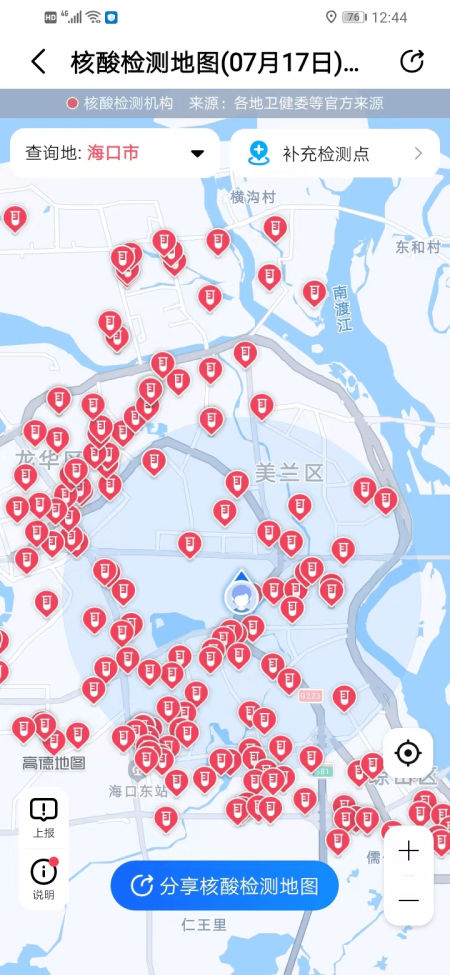
Example of nucleic acid test map.
During Halloween parties in Shanghai in 2022, some people even came dressed up as nucleic test booths – although local authorities could not appreciate the creative costume.
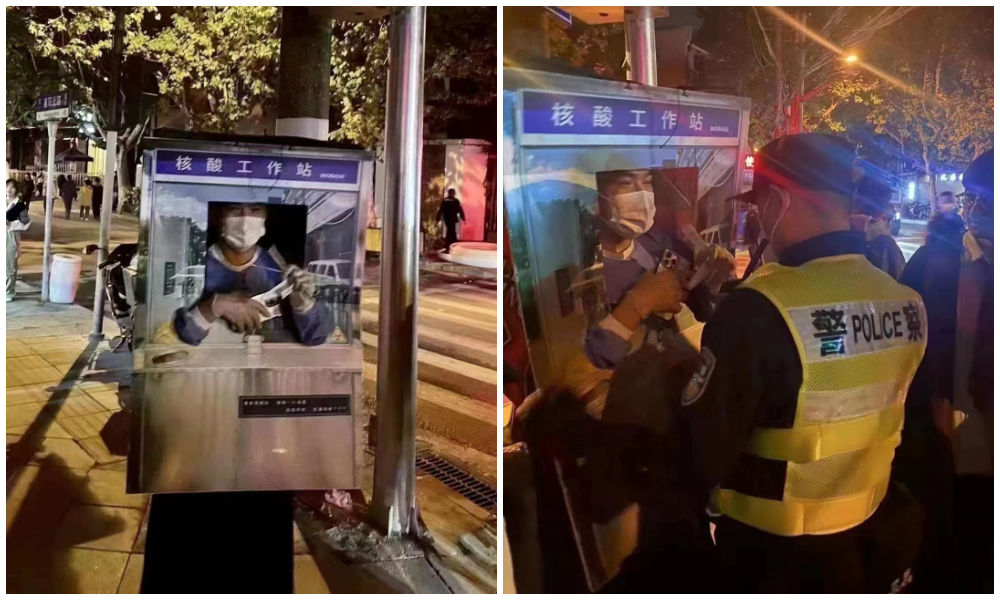
Halloween 2022: dressed up as nucliec acid booths. Via @manyapan twitter.
In December 2022, along with the announced changed rules in China’s ‘zero Covid’ approach, nucleic acid booths were suddenly left dismantled and empty.
With many cities spending millions to set up these booths in central locations, the question soon arose: what should they do with the abandoned booths?
This question also relates to who actually owns them, since the ownership is mixed. Some booths were purchased by authorities, others were bought by companies, and there are also local communities owning their own testing booths. Depending on the contracts and legal implications, not all booths are able to get a new function or be removed yet (Worker’s Daily).
In Tianjin, a total of 266 nucleic acid booths located in Jinghai District were listed for public acquisition earlier this month, and they were acquired for 4.78 million yuan (US$683.300) by a local food and beverage company which will transform the booths into convenience service points, selling snacks or providing other services.
Tianjin is not the only city where old nucleic acid testing booths are being repurposed. While some booths have been discarded, some companies and/or local governments – in cooperation with local communities – have demonstrated creativity by transforming the booths into new landmarks. Since the start of 2023, different cities and districts across China have already begun to repurpose testing booths. Here, we will explore ten different way in which China’s abandoned nucleic test booths get a second chance at a meaningful existence.
1: Pharmacy/Medical Booths
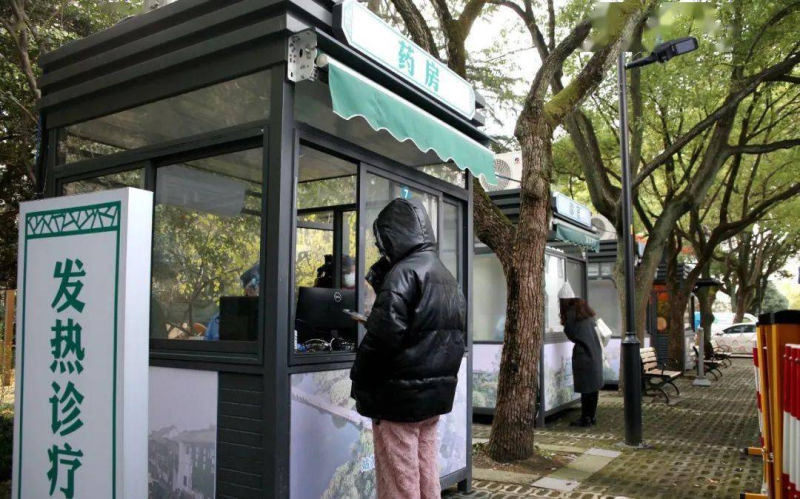
Via ‘copyquan’ republished on Sohu.
Blogger ‘copyquan’ recently explored various ways in which abandoned PCR testing points are being repurposed.
One way in which they are used is as small pharmacies or as medical service points for local residents (居民医疗点). Alleviating the strain on hospitals and pharmacies, this was one of the earliest ways in which the booths were repurposed back in December of 2022 and January of 2023.
Chongqing, Tianjin, and Suzhou were among earlier cities where some testing booths were transformed into convenient medical facilities.
2: Market Stalls
In Suzhou, Jiangsu province, the local government transformed vacant nucleic acid booths into market stalls for the Spring Festival in January 2022, offering them free of charge to businesses to sell local products, snacks, and traditional New Year goods.
The idea was not just meant as a way for small businesses to conveniently sell to local residents, it was also meant as a way to attract more shoppers and promote other businesses in the neighborhood.
3: Community Service Center
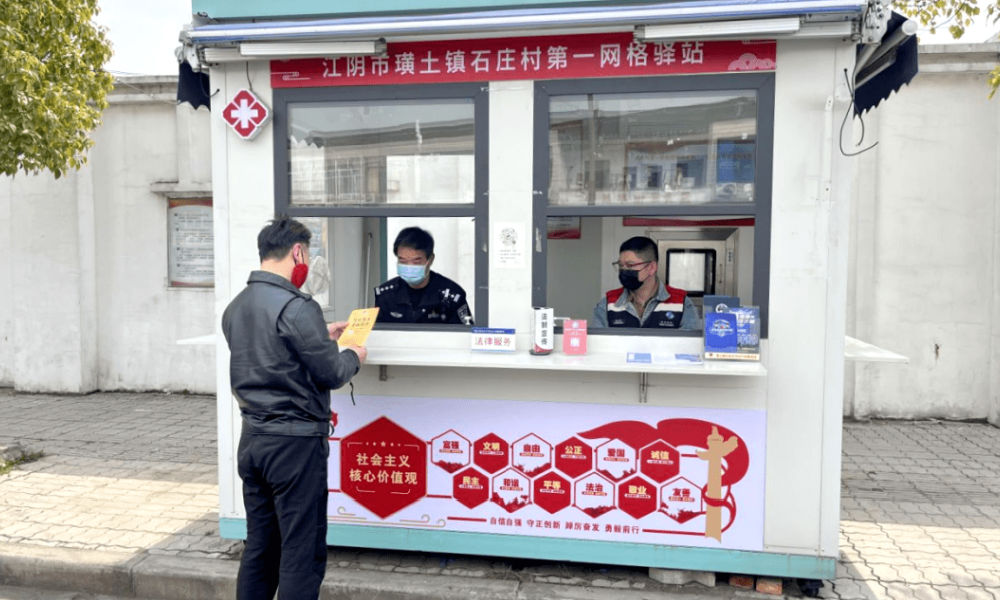
Small grid community center in Shizhuang Village, image via Sohu.
Some residential areas have transformed their local nucleic acid testing booths into community service centers, offering all kinds of convenient services to neighborhood residents.
These little station are called wǎnggé yìzhàn (网格驿站) or “grid service stations,” and they can serve as small community centers where residents can get various kinds of care and support.
4: “Refuel” Stations
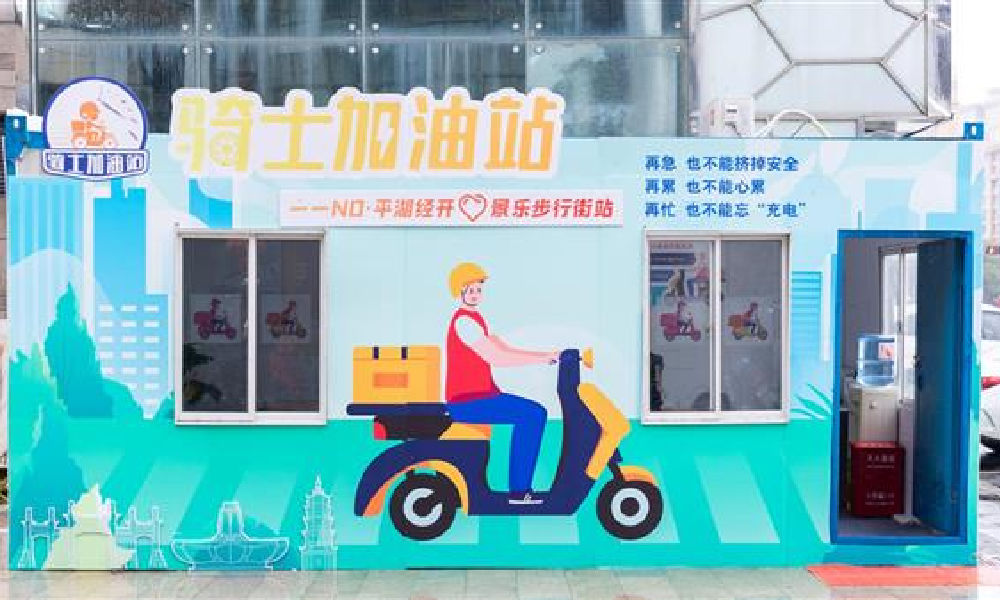
In February of this year, 100 idle nucleic acid sampling booths were transformed into so-called “Rider Refuel Stations” (骑士加油站) in Zhejiang’s Pinghu. Although it initially sounds like a place where delivery riders can fill up their fuel tanks, it is actually meant as a place where they themselves can recharge.
Delivery riders and other outdoor workers can come to the ‘refuel’ station to drink some water or tea, warm their hands, warm up some food and take a quick nap.
5: Free Libraries
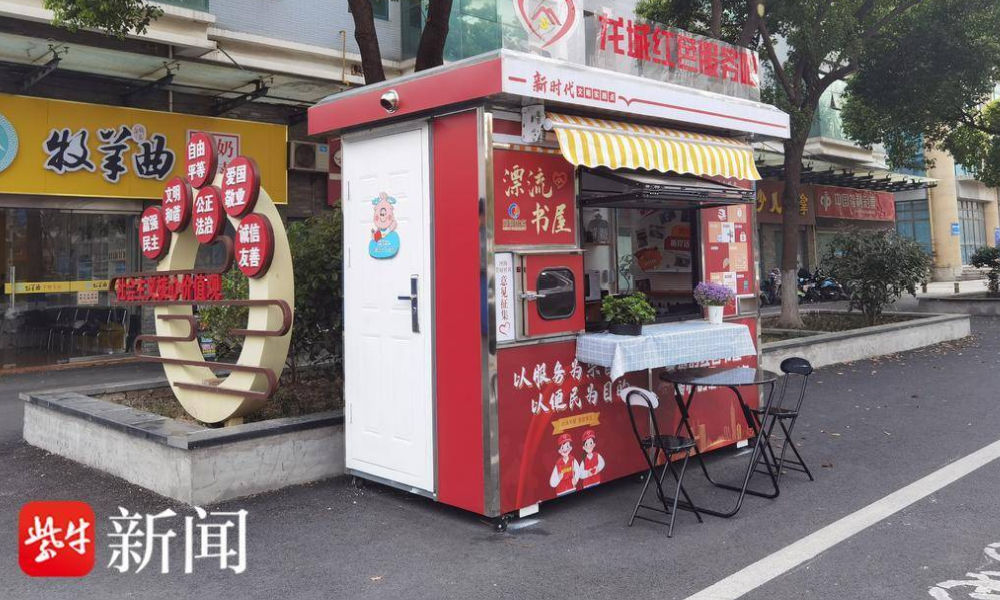
image via sohu.
In various Chinese cities, abandoned nucleic acid booths have been transformed into little free libraries where people can grab some books to read, donate or return other books, and sit down for some reading.
Changzhou is one of the places where you’ll find such “drifting bookstores” (漂流书屋) (see video), but similar initiatives have also been launched in other places, including Suzhou.
6: Study Space

Photos via Copyquan’s article on Sohu.
Another innovative way in which old testing points are being repurposed is by turning them into places where students can sit together to study. The so-called “Let’s Study Space” (一间习吧), fully airconditioned, are opened from 8 in the morning until 22:00 at night.
Students – or any citizens who would like a nice place to study – can make online reservations with their ID cards and scan a QR code to enter the study rooms.
There are currently ten study booths in Anji, and the popular project is an initiative by the Anji County Library in Zhejiang (see video).
7: Beer Kiosk

Hoegaarden beer shop, image via Creative Adquan.
Changing an old nucleic acid testing booth into a beer bar is a marketing initiative by the Shanghai McCann ad agency for the Belgium beer brand Hoegaarden.
The idea behind the bar is to celebrate a new spring after the pandemic. The ad agency has revamped a total of six formr nucleic acid booths into small Hoegaarden ‘beer gardens.’
8: Police Box
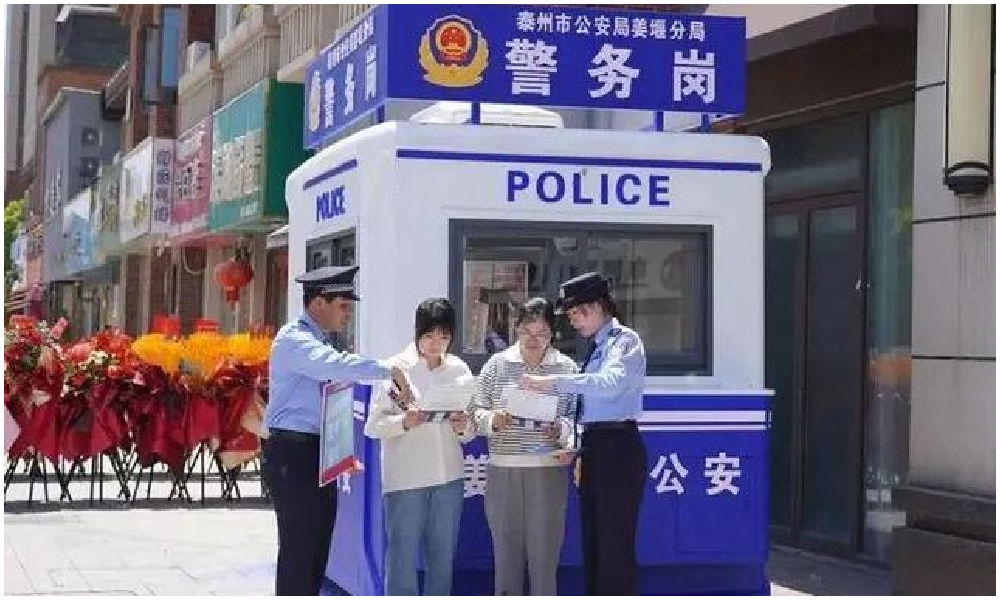
In Taizhou City, Jiangsu Province, authorities have repurposed old testing booths and transformed them into ‘police boxes’ (警务岗亭) to enhance security and improve the visibility of city police among the public.
Currently, a total of eight vacant nucleic acid booths have been renovated into modern police stations, serving as key points for police presence and interaction with the community.
9: Lottery Ticket Booths
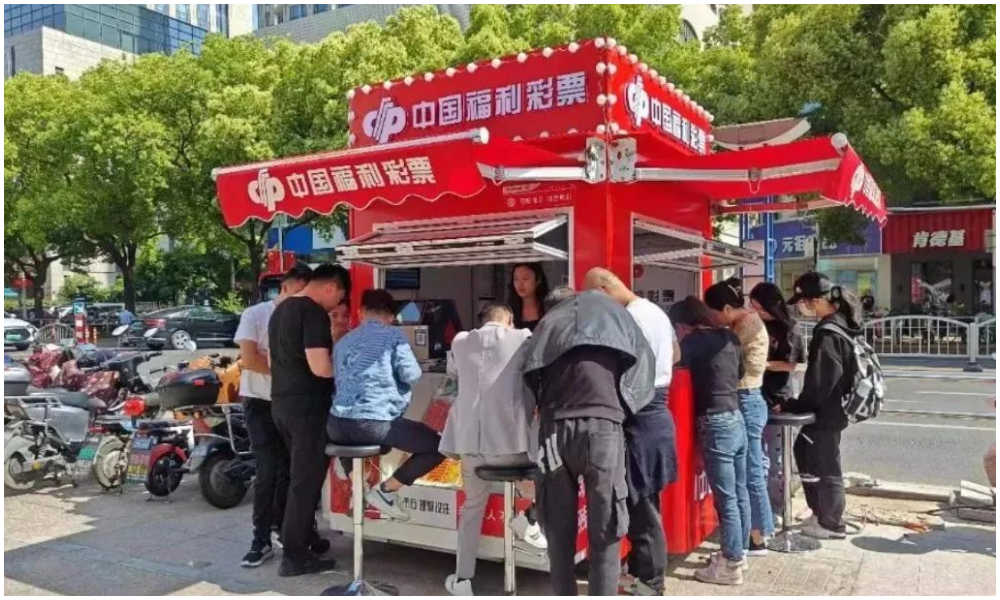
Image via The Paper
Some nucleic acid booths have now been turned into small shops selling lottery tickets for the China Welfare Lottery. One such place turning the kiosks into lottery shops is Songjiang in Shanghai.
Using the booths like this is a win-win situation: they are placed in central locations so it is more convenient for locals to get their lottery tickets, and on the other hand, the sales also help the community, as the profits are used for welfare projects, including care for the elderly.
10: Mini Fire Stations

Micro fire stations, images via ZjNews.
Some communities decided that it would be useful to repurpose the testing points and turn them into mini fire kiosks, just allowing enough space for the necessary equipment to quickly respond to fire emergencies.
Want to read more about the end of ‘zero Covid’ in China? Check our other articles here.
By Manya Koetse,
Get the story behind the hashtag. Subscribe to What’s on Weibo here to receive our newsletter and get access to our latest articles:
Spotted a mistake or want to add something? Please let us know in comments below or email us. First-time commenters, please be patient – we will have to manually approve your comment before it appears.
©2023 Whatsonweibo. All rights reserved. Do not reproduce our content without permission – you can contact us at info@whatsonweibo.com.
Subscribe

Weibo Watch: The Future is Here

“Bye Bye Biden”: Biden’s Many Nicknames in Chinese

Enjoying the ‘Sea’ in Beijing’s Ditan Park

A Triumph for “Comrade Trump”: Chinese Social Media Reactions to Trump Rally Shooting

Weibo Watch: Get Up, Stand Up

The Tragic Story of “Fat Cat”: How a Chinese Gamer’s Suicide Went Viral

“Old Bull Eating Young Grass”: 86-Year-Old Chinese Painter Fan Zeng Marries 36-Year-Old Xu Meng

A Brew of Controversy: Lu Xun and LELECHA’s ‘Smoky’ Oolong Tea

Singing Competition or Patriotic Fight? Hunan TV’s ‘Singer 2024’ Stirs Nationalistic Sentiments

Zara Dress Goes Viral in China for Resemblance to Haidilao Apron

Weibo Watch: The Battle for the Bottom Bed

About the “AI Chatbot Based on Xi Jinping” Story

China’s Intensified Social Media Propaganda: “Taiwan Must Return to Motherland”

Weibo Watch: Telling China’s Stories Wrong

Saying Goodbye to “Uncle Wang”: Wang Wenbin Becomes Chinese Ambassador to Cambodia
Get in touch
Would you like to become a contributor, or do you have any tips or suggestions? Get in touch here!
Popular Reads
-

 China Insight3 months ago
China Insight3 months agoThe Tragic Story of “Fat Cat”: How a Chinese Gamer’s Suicide Went Viral
-

 China Music4 months ago
China Music4 months agoThe Chinese Viral TikTok Song Explained (No, It’s Not About Samsung)
-

 China Digital10 months ago
China Digital10 months agoToo Sexy for Weibo? Online Discussions on the Concept of ‘Cābiān’
-

 China Arts & Entertainment12 months ago
China Arts & Entertainment12 months agoBehind 8 Billion Streams: Who is Dao Lang Cursing in the Chinese Hit Song ‘Luocha Kingdom’?


